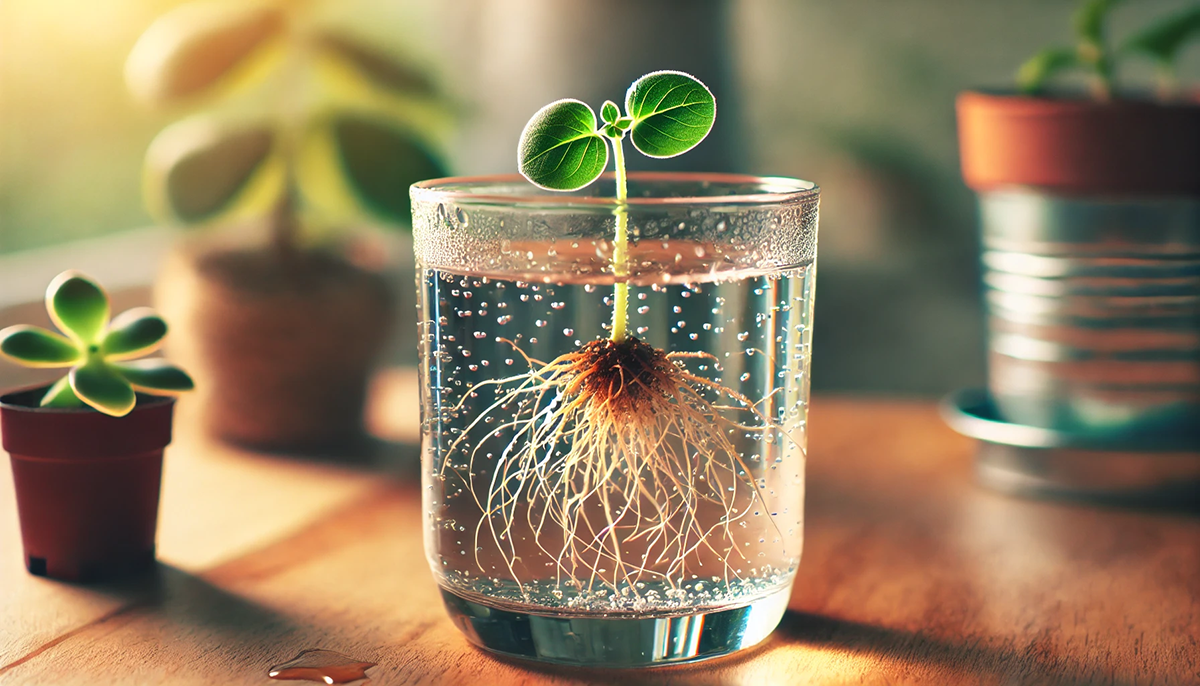How to Root Cuttings with Hydrogen Peroxide – A Proven Method for Plant Propagation

Plant propagation through cuttings is a well-established technique to create genetically identical offspring of a plant. While many gardeners rely on traditional methods such as rooting in water or soil, there is a lesser-known but highly effective trick: rooting cuttings with hydrogen peroxide (H₂O₂). This method can boost root development, improve plant health, and reduce the risk of infections.
Why Choose Cutting Propagation?
Propagation through cuttings offers several advantages over growing from seeds. Unlike seeds, which must go through a delicate germination stage, cuttings already start as small plants with leaves, reducing the growth time. Additionally, cuttings retain all the genetic characteristics of the mother plant, which is particularly important for cannabis cultivation, ensuring that the new plant is female and carries the desired traits.
While seed-grown plants often develop stronger root systems due to their primary taproot anchoring deep into the soil, cuttings can still grow into healthy, productive plants with proper care.
How to Take a Cutting Properly
For successful rooting, the first step—cutting the plant—is crucial. Follow these guidelines for the best results:
- Choose a strong mother plant: The donor plant should be healthy, robust, and high-yielding. Any disease or nutrient deficiency in the mother plant may be transferred to the cutting.
- Use sterilized tools: A clean, sharp knife or scissors is essential to prevent infections. The cut should be made at a 45-degree angle just below a node.
- Size and structure: The cutting should have at least two nodes and be 10-15 cm (4-6 inches) long.
After cutting, remove the lower leaves to help the plant focus its energy on root formation rather than foliage maintenance.
Rooting Cuttings – Overview of Methods
Once the cutting is prepared, it needs to be placed in an appropriate rooting medium as soon as possible. Here are the most effective methods:
Rooting Cuttings in Water
A traditional and widely used method involves placing the cutting in a glass of clean water, ensuring at least one node is submerged. A transparent glass is ideal for monitoring root development.
To prevent bacterial growth and rot, change the water every 48 hours. Covering the container with plastic wrap (with small holes) can help maintain humidity, further promoting root formation.
Rooting Cuttings with Hydrogen Peroxide
A lesser-known but highly effective method is using hydrogen peroxide (H₂O₂) to encourage root growth. H₂O₂ provides several key benefits:
- It acts as a disinfectant, preventing root rot.
- It increases oxygen availability in the water, accelerating root development.
- It helps reduce bacteria, mold, and fungal growth.
Steps:
- Prepare a glass or container with clean water.
- Add two drops of 3% hydrogen peroxide (commonly found in pharmacies) per 100 ml of water.
- Place the cutting into the water, ensuring at least one node is submerged.
- Change the water every two days, adding fresh hydrogen peroxide each time.
Roots typically begin forming within 10-15 days. If no roots appear after this period, factors such as water temperature, plant health, or oxygen levels may need to be adjusted.
Rooting Cuttings in Soil
Alternatively, cuttings can be placed directly in the soil. This method requires a light, well-aerated soil mixture with at least 25-50% perlite to prevent excessive moisture retention.
Process:
- Moisten the soil thoroughly and allow it to drain.
- Dip the base of the cutting in a rooting hormone.
- Plant the cutting about 2-3 cm deep in the soil and gently press the soil around the stem.
- Place the pot in a humidity dome or cover it with plastic wrap to maintain high moisture levels.
- Mist the leaves regularly to prevent dehydration.
Roots should develop within one to two weeks. Once the cutting establishes a strong root system, it can be transplanted into a larger pot or outdoor garden.
Homemade Rooting Hormones
Commercial rooting hormones like Clonex or Cloner Boom are highly effective, but there are also natural alternatives that can be made at home.
One of the best methods involves using sprouted legumes (such as lentils, soybeans, or chickpeas), which contain high levels of auxins, the plant hormones responsible for stimulating root growth.
How to Make a Natural Rooting Hormone:
- Soak a handful of lentils or chickpeas in water for 3-4 days until they sprout.
- Blend the sprouted seeds with their soaking water.
- Strain the mixture to extract a clear liquid.
- Soak the cuttings in this solution for one hour before planting, or use it as a nutrient-rich watering liquid.
This eco-friendly alternative to synthetic hormones delivers excellent results and is simple to prepare.
Conclusion
Rooting cuttings with hydrogen peroxide is a simple yet highly effective method to encourage root growth and successfully propagate new plants. Its disinfecting and oxygenating properties promote faster and healthier root formation.
Whether using water, soil, or natural rooting stimulants, proper care and patience will help cuttings develop into strong, thriving plants.
Recommended products on Cannadusa
Athena Pro Line Mix Kit - 110,00€
Atami ATA Rootfast 5L - 98,00€
Plagron Start Up - 52,00€
Recent posts
Author
Contents
© 2024 - 2025 Cannadusa. Powered by Medusa Engineering GmbH
• Impressum • AGB • Datenschutz • Compliance


